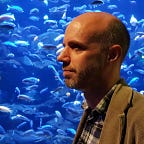‘Northern Exposure’ or –Bill Morrison’s ‘Dawson City: Frozen Time’.
So last night I went to the GFT to see Bill Morrison’s new film ‘Dawson City: Frozen Time’.
I walked into the cinema out of the rain, ordered my usual aesthete fitness drink — tap water with ice — at the bar and settled down in my seat. One of the things people can do at the GFT is sponsor a seat. Give the cinema some money and you get your name on the back of a chair in the auditorium. I looked at the name on the back of the seat in front of me: it read ‘Clyde Cablevision’. “Who the hell has a name like that?!” I thought.
I looked around. The audience was a healthy split between men and women although I couldn’t help noticing how many of the men were, like myself, totally bald. Does Morrison’s work attract bald men? There were so many of us certain sections of the auditorium looked like an open egg-carton.
While the adverts played I leafed through the GFT’s brochure, curious about ‘Dawson City’s run-time, expecting it to be around 85 mins. When I saw it was two hours I almost spat my drink out over Clyde Cablevision. A two hour long Morrison movie?! Most of his work is around seven to fifteen or twenty minutes long with his bigger pieces maxing out around an hour or just over. Could he sustain the length? Would his stylistic technique become grating at this duration?
Fortunately the answer is emphatically “No” as ‘Dawson City: Frozen Time’ is one of Morrison’s most captivating, and most moving, works. It’s a “documentary” similar to his ‘The Great Flood’ and tells the story of the discovery of a load of old black-and-white, silver nitrate silent movies from the very earliest days of cinema found buried under an abandoned swimming pool turned ice-hockey rink in the northern Canadian city of Dawson.
Dawson City was founded during the days of the Klondike gold-rush. Huge numbers (and I had no idea just how many there were) of prospective prospectors set off to the Yukon in search of gold quickly, and inevitably, followed by the corporations and industry. Thus the city of Dawson was created.
Whilst living in this remote city all these people needed something to do. Gambling and drinking were the entertainment for a while until there was a push to clean the place up and several cinemas were built as healthier alternatives for distraction. The city had a huge appetite for film but being so far north and remote, the film distributors refused to pay for the movies to be returned after they had been shown in Dawson. This was, for many film-reels, the end of the line.
There these films sat, constantly threatening to spontaneously explode into flames (were they angry they had been forgotten?) as silver-nitrate film has a wont to do. So they were used as land-fill when the local swimming pool was turned into an ice-rink. There these movies and news-reels lay under the cold earth and ice for decades, surviving through their delicate robustness, until they were unearthed in the 1970s. An act of forgetting had become an act of preservation. But just what was preserved?
Morrison does his usual, wonderful stuff here: taking old silver-nitrate film and creating a narrative from these dazzling fragments. And what we get through these images is a history of Dawson, the gold-rush, the rise of Capitalism and cinema itself. Hollywood might have had an impact on Dawson but Dawson also had an impact on Hollywood when men rich from the gold-rush put their money into the movie business, where films about the gold-rush would then be made. A feed-back loop between Canada and California.
And then it struck me: ‘Dawson City’ deals with a time and with issues that Thomas Pynchon deals with in ‘Against The Day’ — the Ludlow massacre, the destruction of labour movements and the left, anarchist attacks against robber barons and Wall St, revolting miners, film-editing techniques and film references and, of course, explosions. This was an important time that helped defined America to this very day. Advances for workers rights were made at this time — the 8 hour day etc — but, again, a huge amount (like abandoned film) was lost. Capitalism exerted itself, violently flexed its muscles, at this time only to have (temporarily) its own day of reckoning by the end of the 20’s, and ‘Dawson City’ captures all this through dazzling light.
And just how much we get to see of this lost world, how much is revealed to us, is incredible. The way these resurrected images unfold before us is utterly captivating and the way Morrison creates a narrative out of this is very impressive.
This is one of Morrison’s more laid-back works. It doesn’t have the balls-to-the-wall intensity of ‘Decasia’ or the brain-splitting rush of ‘Outerborough’ and it certainly doesn’t have anything as giddingly exhilarating or as overwhelmingly over-stimulating as ‘Spark of Being’s drum solo (but then again, what does?) but the story is so strong here that it doesn’t need all the pyrotechnics which could, in this case, have been more of a distraction. We get the chance to fully immerse ourselves in the story and images. His stylistic tropes are still there but he uses the decayed footage sequences sparingly and when he does they are beautiful, especially the final sequence, a wonderful flourish and love letter to silent film which gave me all the feels. This is a movie so full of heart I’m sure it would’ve made Clyde Cablevision well-up. ‘Dawson City’ starts by saying “Film was born of an explosive” but, like ‘Cinema Paradiso’s box of kisses, film is also emotionally explosive as well as physically.
‘Dawson City: Frozen Time’ contains more than film; it contains love.
